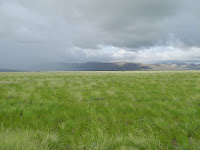Geraniums (Pelargonium xhortorum) had a big rise in popularity during the recent drought in Melbourne. Their native counterpart has many of the attributes and more of the more commonly planted South African species:
Pelargonium Australe
This widespread native species will self seed into a huge range of soil types and conditions, including gravel driveways, pots, rockeries, pretty much anywhere with well drained soils. It can also tolerate heavier soils and compaction. I think it is a great little plant, particularly for a herb/cottage/native garden styles, flowering throughout spring and summer. It also can develop gorgeous red foliage in autumn and winter as a result of colder weather, tolerating a wide range of temperatures. Another Pelargonium species with this feature is the P. rodneyanum that is less vigorous but has a lovely magenta coloured flower. The roots of both species were eaten by Aboriginies in Victoria. The P. rodneyanum has a smaller leaf that is often a glossy deep green rather than dull like the P. australe.
These P. australe were found their way (self-sown) into my silverbeet container. Long after the silverbeet had gone in summer and the pot out of use receiving no additional water, these little pelargoniums remained. So they were transplanted into the windowsill planter box below, facing south where there is very little direct sunlight. They may not reach their full size (small rounded bush to 50cm) in this situation or I may have to thin them out to encourage bushiness.








